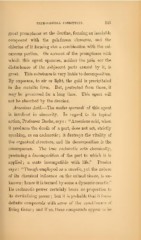Page 249 - My FlipBook
P. 249
PATHOLOGICAL CONDITIONS. 245
great promptness on the dentine, forming an insoluble
compound with the gelatinous elements, and the
chlorine of it forming also a combination with the cal-
careous portion. On account of the promptness with
which this agent operates, neither the pain nor the
disturbance of the subjacent parts caused by it, is
great. This substance is very liable to decomposition.
By exposure, to air or light, the gold is precipitated
in the metallic form. But, protected from these, it
may be preserved for a long time. This agent will
not be absorbed by the dentine.
Arsenious Acid.—The modus operandi of this agent
is involved in obscurity. In regard to its topical
action, Professor Bache, says : "Arsenious acid, when
it produces the death of a part, does not act, strictly
speaking, as an escharotic ; it destroys the vitality of
the organized structure, and its decomposition is the
consequence. The true escharotic acts chemically,
producing a decomposition of the part to which it is
applied; a state incompatible with life." Pereira
says : " Though employed as a caustic, yet the nature
of its chemical influence on the animal tissue, is un-
known; hence it is termed by some a dynamic caustic."
Its escharotic power certainly bears no proportion to
its devitalizing power; but it is probable that it forms
definite compounds with some of the constituents of
living tissue; and if so, these compounds appear to be


